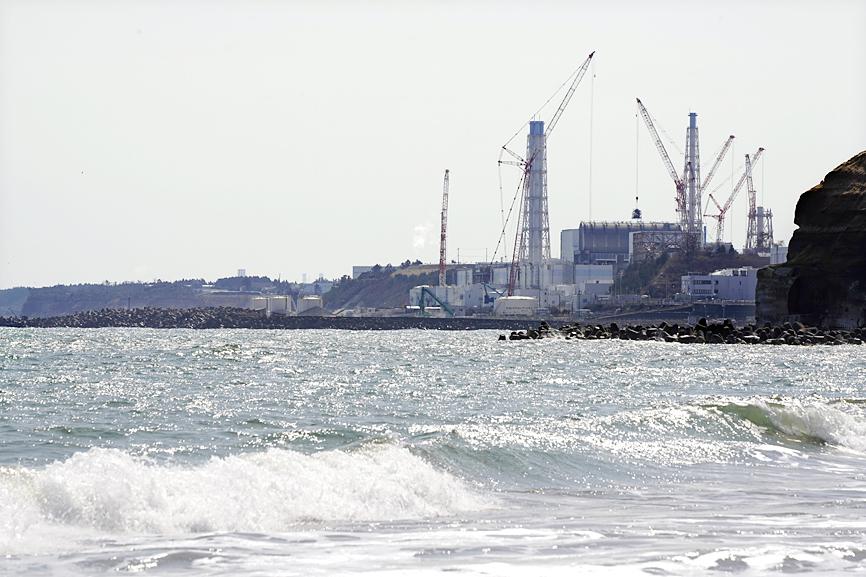Operators of Japan’s stricken Fukushima Dai-ichi nuclear power plant on Wednesday unveiled plans to construct an undersea tunnel to release more than 1 million tonnes of treated water from the site into the ocean.
Plans for the 1km tunnel were announced after the Japanese government decided in April to release the accumulated water in 2023.
Ministers have said that the release should be safe because the water is to be processed to remove almost all radioactive elements, then diluted.

Photo: EPA-EFE
However, the decision triggered an outcry from neighboring countries and fierce opposition from local fishing communities.
Tokyo Electric Power Co (TEPCO) said that it plans to start building the tunnel by March next year after carrying out feasibility studies and obtaining approval from authorities.
With a diameter of about 2.5m and stretching east into the Pacific, the tunnel is to carry 1.27 million tonnes of treated water from tanks at the plant.
That includes water used for cooling the plant, which was crippled after going into meltdown following a huge 2011 tsunami, as well as rain and groundwater that seeps in daily.
An extensive pumping and filtration system extracts tonnes of newly contaminated water each day and filters out most radioactive elements.
However, fishing communities fear that releasing the water would undermine years of work in restoring consumer confidence in local seafood.
The plant’s chief decommissioning officer, Akira Ono, said that releasing the water through a tunnel would help prevent it from flowing back to shore.
“We will thoroughly explain our safety policies and the measures we are taking against reputation damage so that we can dispel concerns held by people involved in fisheries” and other industries, Ono said.
In a statement, TEPCO said that it was ready to pay compensation for reputational damage related to the release.
TEPCO also said it would accept inspections by the International Atomic Energy Agency on the safety of the release.
The agency has endorsed Japan’s decision.
Japanese Prime Minister Yoshihide Suga has called disposing of the water an “inevitable task” in the decades-long process of decommissioning the nuclear plant.
Debate over how to handle the water has dragged on for years, as space to store it at the site runs out.
The filtration process removes most radioactive elements from the water, but some remain, including tritium.
Experts say that the element is only harmful to humans in large doses, and with dilution, the treated water poses no scientifically detectable risk.

Super Typhoon Kong-rey is the largest cyclone to impact Taiwan in 27 years, the Central Weather Administration (CWA) said today. Kong-rey’s radius of maximum wind (RMW) — the distance between the center of a cyclone and its band of strongest winds — has expanded to 320km, CWA forecaster Chang Chun-yao (張竣堯) said. The last time a typhoon of comparable strength with an RMW larger than 300km made landfall in Taiwan was Typhoon Herb in 1996, he said. Herb made landfall between Keelung and Suao (蘇澳) in Yilan County with an RMW of 350km, Chang said. The weather station in Alishan (阿里山) recorded 1.09m of

NO WORK, CLASS: President William Lai urged people in the eastern, southern and northern parts of the country to be on alert, with Typhoon Kong-rey approaching Typhoon Kong-rey is expected to make landfall on Taiwan’s east coast today, with work and classes canceled nationwide. Packing gusts of nearly 300kph, the storm yesterday intensified into a typhoon and was expected to gain even more strength before hitting Taitung County, the US Navy’s Joint Typhoon Warning Center said. The storm is forecast to cross Taiwan’s south, enter the Taiwan Strait and head toward China, the Central Weather Administration (CWA) said. The CWA labeled the storm a “strong typhoon,” the most powerful on its scale. Up to 1.2m of rainfall was expected in mountainous areas of eastern Taiwan and destructive winds are likely

The Central Weather Administration (CWA) yesterday at 5:30pm issued a sea warning for Typhoon Kong-rey as the storm drew closer to the east coast. As of 8pm yesterday, the storm was 670km southeast of Oluanpi (鵝鑾鼻) and traveling northwest at 12kph to 16kph. It was packing maximum sustained winds of 162kph and gusts of up to 198kph, the CWA said. A land warning might be issued this morning for the storm, which is expected to have the strongest impact on Taiwan from tonight to early Friday morning, the agency said. Orchid Island (Lanyu, 蘭嶼) and Green Island (綠島) canceled classes and work

KONG-REY: A woman was killed in a vehicle hit by a tree, while 205 people were injured as the storm moved across the nation and entered the Taiwan Strait Typhoon Kong-rey slammed into Taiwan yesterday as one of the biggest storms to hit the nation in decades, whipping up 10m waves, triggering floods and claiming at least one life. Kong-rey made landfall in Taitung County’s Chenggong Township (成功) at 1:40pm, the Central Weather Administration (CWA) said. The typhoon — the first in Taiwan’s history to make landfall after mid-October — was moving north-northwest at 21kph when it hit land, CWA data showed. The fast-moving storm was packing maximum sustained winds of 184kph, with gusts of up to 227kph, CWA data showed. It was the same strength as Typhoon Gaemi, which was the most